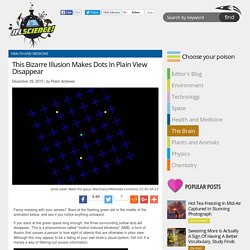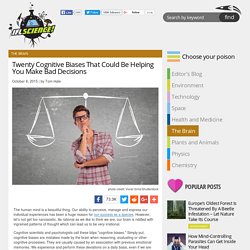

This Bizarre Illusion Makes You See A "Hole" In Your Hand. Vanessa Hill has shown a simple and brain-bending optical illusion on her YouTube channel BrainCraft that makes a "hole" emerge in the palm of your hand.

All you need is a narrow tube made out of rolled-up paper. Place your hand roughly 5 centimeters (2 inches) in front of one of your eyes, while you look down the tube with the other. For at least 10 seconds, try to focus on the sight in the distance through the tube and not your hand. After a while, it will appear that you can see through a hole in your hand. As Hill explains in the video, it’s all to do with a phenomenon called binocular rivalry. In this case, the effect tends to suppress the hand as it’s the weaker stimulus and not in focus. Check out Hill’s video to learn more about the optical illusion. This Bizarre Illusion Makes Dots In Plain View Disappear. Fancy messing with your senses?

Stare at the flashing green dot in the middle of the animation below, and see if you notice anything untoward. If you stare at the green speck long enough, the three surrounding yellow dots will disappear. This is a phenomenon called “motion-induced blindness” (MIB), a form of illusion that causes a person to lose sight of objects that are otherwise in plain view. Although this may appear to be a failing of your own brain’s visual system, fret not: It is merely a way of filtering out excess information.
GIF credit: Mlechowicz/Wikimedia Commons; CC BY-SA 3.0 A 2008 study by two researchers at Yale University note that these yellow dots may represent a type of scotoma, or “blind spot.” According to common theories behind MIB, the reason you are not seeing the yellow dots is due to a phenomenon called sensory overload. The brain, after all, does not automatically process all information, visual or otherwise, that the body’s sensory systems encounter. This Image Can Trick Your Brain And Make You See It In Color. Perception is a fickle thing.

As good as our senses are at keeping us alive, they can often mislead and deceive us. Here’s a great example of that which you can try at home, featured in the new BBC Four series, Colour: The Spectrum of Science. Check out the video below, follow the instructions and see a black and white image turn into a full-color image of a landscape. It’s all to do with our cone cells, one of the two types of photoreceptors within our eye’s retina, which are responsible for color vision. We have three types of cones, which are sensitive to blue, green or red wavelengths of light. Twenty Cognitive Biases That Could Be Helping You Make Bad Decisions.
The human mind is a beautiful thing.

Our ability to perceive, manage and express our individual experiences has been a huge reason for our success as a species. However, let’s not get too narcissistic. As rational as we like to think we are, our brain is riddled with ingrained patterns of thought which can lead us to be very irrational. Cognitive scientists and psychologists call these blips "cognitive biases.
" Simply put, cognitive biases are mistakes made by the brain when reasoning, evaluating or other cognitive processes. This neat infographic from Business Insider, created by graphic designer Samantha Lee and reporter Shana Lebowitz, shows 20 of these cognitive biases that make us realize how irrational and malleable our little meat-bag brains can be. Image credit: Samantha Lee and Shana Lebowitz/Business Insider. 60 Most Amazing Optical Illusion and Paradox Pictures You Must See. An optical illusion (also known as visual illusion) is characterized by visually perceived images that differ from objective reality.

The information gathered by the eye is processed in the brain to give a perception that does not tally with a physical measurement of the stimulus source. Today we’ve crawled deep into the Internet and gathered 60 incredibly amazing illusion pictures that can stimulate your brain! In this comprehensive collection, you can find many visual perceptions, optical illusions, paradoxes, and perception puzzles. Test Your Awareness : Whodunnit? Hjärnan sorterar bort verkligheten. Ser du på dig själv som en miljövänlig person?

Då går du säkert till återvinningsstationen med dina tomma plastförpackningar. Fast med största säkerhet har det nog också hänt att du har slängt plastförpackningar i hushållssoporna en gång eller två. Och när det gäller dig själv har du förmodligen ett helt gäng med förklaringar: du hade bråttom, det var fullt i plastbehållaren, för en gångs skull orkade du inte. Eller något liknande. Men när du ser någon annan slänga sina förpackningar i hushållssoporna, vad tänker du om den personen? Om du är som de flesta andra av oss drar du förmodligen till med förklaringar som att personen inte är miljövänlig, är oansvarig eller kanske rentav dum. Det betyder att du just har fallit i en vanlig tankefälla som kallas för det fundamentala attributionsfelet: när du själv gör något dumt beror det på situationen, när andra gör något dumt beror det på någon av deras egenskaper. – Jag tycker att framingeffekten är en av de mest intressanta. Elizabeth Loftus: How reliable is your memory?